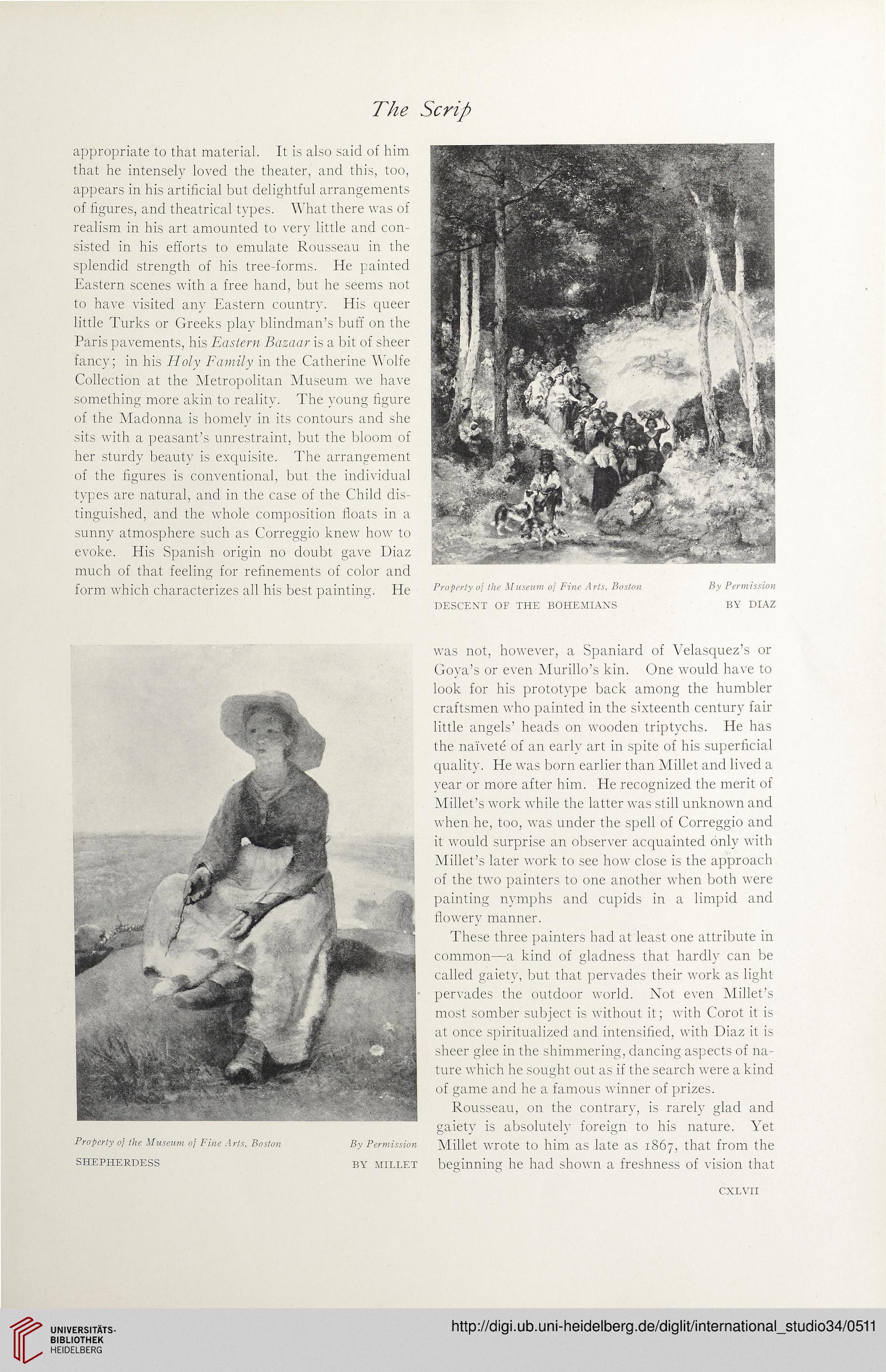The Scrip
appropriate to that material. It is also said of him
that he intensely loved the theater, and this, too,
appears in his artificial but delightful arrangements
of figures, and theatrical types. What there was of
realism in his art amounted to very little and con-
sisted in his efforts to emulate Rousseau in the
splendid strength of his tree-forms. He painted
Eastern scenes with a free hand, but he seems not
to have visited any Eastern country. His queer
little Turks or Greeks play blindman’s buff on the
Paris pavements, his Eastern Bazaar is a bit of sheer
fancy; in his Holy Family in the Catherine Wolfe
Collection at the Metropolitan Museum we have
something more akin to reality. The young figure
of the Madonna is homely in its contours and she
sits with a peasant’s unrestraint, but the bloom of
her sturdy beauty is exquisite. The arrangement
of the figures is conventional, but the individual
types are natural, and in the case of the Child dis-
tinguished, and the whole composition floats in a
sunny atmosphere such as Correggio knew how to
evoke. His Spanish origin no doubt gave Diaz
much of that feeling for refinements of color and
form which characterizes all his best painting. He Properly of the Museum of Fine Arts, Boston
DESCENT OF THE BOHEMIANS
By Permission
BY DIAZ
was not, however, a Spaniard of Velasquez’s or
Goya’s or even Murillo’s kin. One would have to
look for his prototype back among the humbler
craftsmen who painted in the sixteenth century fair
little angels’ heads on wooden triptychs. He has
the naivete of an early art in spite of his superficial
quality. He was born earlier than Millet and lived a
year or more after him. He recognized the merit of
Millet’s work while the latter was still unknown and
when he, too, was under the spell of Correggio and
it would surprise an observer acquainted only with
Millet’s later work to see how close is the approach
of the two painters to one another when both were
painting nymphs and cupids in a limpid and
flowery manner.
These three painters had at least one attribute in
common—a kind of gladness that hardly can be
called gaiety, but that pervades their work as light
pervades the outdoor world. Not even Millet’s
most somber subject is without it; with Corot it is
at once spiritualized and intensified, with Diaz it is
sheer glee in the shimmering, dancing aspects of na-
ture which he sought out as if the search were a kind
of game and he a famous winner of prizes.
Rousseau, on the contrary, is rarely glad and
gaiety is absolutely foreign to his nature. Yet
Millet wrote to him as late as 1867, that from the
beginning he had shown a freshness of vision that
By Permission
BY MILLET
Properly of the Museum of Fine Arts, Boston
SHEPHERDESS
CXLVII
appropriate to that material. It is also said of him
that he intensely loved the theater, and this, too,
appears in his artificial but delightful arrangements
of figures, and theatrical types. What there was of
realism in his art amounted to very little and con-
sisted in his efforts to emulate Rousseau in the
splendid strength of his tree-forms. He painted
Eastern scenes with a free hand, but he seems not
to have visited any Eastern country. His queer
little Turks or Greeks play blindman’s buff on the
Paris pavements, his Eastern Bazaar is a bit of sheer
fancy; in his Holy Family in the Catherine Wolfe
Collection at the Metropolitan Museum we have
something more akin to reality. The young figure
of the Madonna is homely in its contours and she
sits with a peasant’s unrestraint, but the bloom of
her sturdy beauty is exquisite. The arrangement
of the figures is conventional, but the individual
types are natural, and in the case of the Child dis-
tinguished, and the whole composition floats in a
sunny atmosphere such as Correggio knew how to
evoke. His Spanish origin no doubt gave Diaz
much of that feeling for refinements of color and
form which characterizes all his best painting. He Properly of the Museum of Fine Arts, Boston
DESCENT OF THE BOHEMIANS
By Permission
BY DIAZ
was not, however, a Spaniard of Velasquez’s or
Goya’s or even Murillo’s kin. One would have to
look for his prototype back among the humbler
craftsmen who painted in the sixteenth century fair
little angels’ heads on wooden triptychs. He has
the naivete of an early art in spite of his superficial
quality. He was born earlier than Millet and lived a
year or more after him. He recognized the merit of
Millet’s work while the latter was still unknown and
when he, too, was under the spell of Correggio and
it would surprise an observer acquainted only with
Millet’s later work to see how close is the approach
of the two painters to one another when both were
painting nymphs and cupids in a limpid and
flowery manner.
These three painters had at least one attribute in
common—a kind of gladness that hardly can be
called gaiety, but that pervades their work as light
pervades the outdoor world. Not even Millet’s
most somber subject is without it; with Corot it is
at once spiritualized and intensified, with Diaz it is
sheer glee in the shimmering, dancing aspects of na-
ture which he sought out as if the search were a kind
of game and he a famous winner of prizes.
Rousseau, on the contrary, is rarely glad and
gaiety is absolutely foreign to his nature. Yet
Millet wrote to him as late as 1867, that from the
beginning he had shown a freshness of vision that
By Permission
BY MILLET
Properly of the Museum of Fine Arts, Boston
SHEPHERDESS
CXLVII





